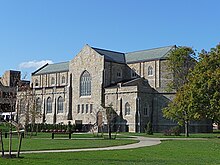
Rensselaer Polytechnic Institute is a private research university in Troy, New York, with an additional campus in Hartford, Connecticut. A third campus in Groton, Connecticut, closed in 2018. RPI was established in 1824 by Stephen Van Rensselaer and Amos Eaton for the "application of science to the common purposes of life" and is the oldest technological university in the English-speaking world and the Western Hemisphere.
There are several songs about Rensselaer Polytechnic Institute traditionally sung at special events.
WRPI is a non-commercial free-format college radio station run entirely by students attending Rensselaer Polytechnic Institute and staffed by community members and students. WRPI broadcasts every day with an effective radiated power of 10,000 watts, serving listeners in Albany, eastern New York, western Massachusetts, Vermont, and online via live streaming. The studios are located in the basement of the Darrin Communications Center and the FM signal is broadcast from North Greenbush. Programming includes a wide range of music, cultural and public affairs programs, live bands, special events, and sports simulcasts, particularly of RPI hockey, football, and baseball. WRPI has a large record library dating to the origins of the station, estimated at 43,800 albums, and a large CD library, dating to the start of the medium.
The main campus of Virginia Tech is located in Blacksburg, Virginia; the central campus is roughly bordered by Prices Fork Road to the northwest, Plantation Road to the west, Main Street to the east, and U.S. Route 460 bypass to the south, although it also has several thousand acres beyond the central campus. The Virginia Tech campus consists of 130 buildings on approximately 2,600 acres (11 km2). It was the site of the Draper's Meadow massacre in 1755 during the French and Indian War.

The Shirley Ann Jackson, Ph.D. Center for Biotechnology and Interdisciplinary Studies is a research facility at Rensselaer Polytechnic Institute (RPI). The 218,000-square-foot (20,300 m2) building is located on 15th street between RPI’s Playhouse and Academy Hall, next to the Center for Industrial Innovation. The institute hopes the new facility will help to encourage collaboration between experts in different fields, allowing them to solve problems that they would be unable to solve alone. As of 2008, the director of the center is Jonathan Dordick. The building cost $100M.
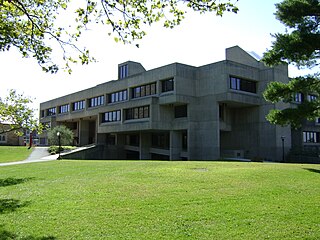
The Richard G. Folsom Library is a research library in the Rensselaer Libraries system constructed in the Brutalist style located on the campus of Rensselaer Polytechnic Institute in Troy, NY. It is named after Richard Gilman Folsom, the President of the Institute from 1958–1971. The Folsom Library offers a variety of services to students and patrons of the library. In addition to loans, these services include class reserves, general writing and presentation assistance through the Center for Communication Practices, cultural and educational events, inter-library loans through ConnectNY, individual and group room reservations, computer labs, and wireless internet.

The Carnegie Building is the current home of the Cognitive Science Department at Rensselaer Polytechnic Institute in Troy, New York. It is one of the westernmost buildings on the campus and as such provides scenic views overlooking the city of Troy and the Hudson River. The four-story building is named for Andrew Carnegie who donated $125,000 for its construction, which was completed in 1906.
Amos Eaton Hall is the current home of the Department of Mathematical Sciences at Rensselaer Polytechnic Institute in Troy, NY. It is named for Amos Eaton, the co-founder and first senior professor of Rensselaer. Amos Eaton Hall is the only building on the campus referred to by both first and last name. The building opened in 1928.
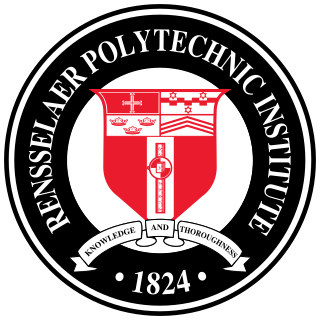
Rensselaer at Work is the online division of Rensselaer Polytechnic Institute, operating administratively from facilities in Hartford, Connecticut, since 1955. Until 1997, it was known as the Hartford Graduate Center. The primary focus of the division is to offer graduate-level professional education to learners across the country via its digital delivery.

The Jonsson Engineering Center, is home to the School of Engineering at Rensselaer Polytechnic Institute in Troy, New York. It is named for J. Erik Jonsson and was dedicated on 7 October 1977.
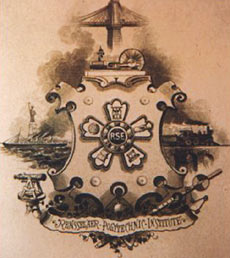
The Rensselaer Society of Engineers (RSE) is a social fraternity founded in 1866 at Rensselaer Polytechnic Institute in Troy, NY. Originally named The Pi Eta Scientific Society, the organization was incorporated in 1873 in the state of New York. Arriving on campus at about the same time as some of the first fraternities, it has remained one of the oldest "local" organizations in the U.S. RSE is the only independent fraternity at Rensselaer. They have chosen to remain independent to maintain the freedom to set their own policies and make their own managerial decisions. Contrary to what their name may imply, members major not only in engineering, but also in such disciplines as science, management, architecture, and the arts. Society members are active in not only campus and local activities, but are also in many national organizations.
The Rensselaer Polytechnic is the student-run news organization of Rensselaer Polytechnic Institute. Prior to 2018, it was published in print every Wednesday during the Institute's fall and spring academic calendars, but now publishes online at poly.rpi.edu, following the same schedule.
Palmer Chamberlain Ricketts was the ninth president of Rensselaer Polytechnic Institute. He served as president for 33 years and oversaw a period of major expansion and development of the university.
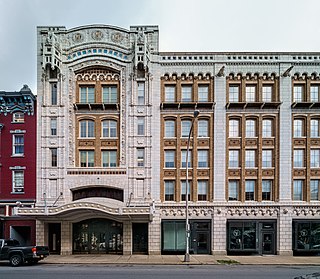
Proctor's Theater is located on Fourth Street in Troy, New York, United States. It was listed on the National Register of Historic Places in 1979, and is a contributing property to the Central Troy Historic District, added to the Register in 1986.
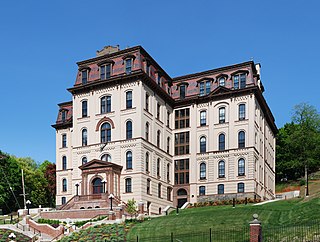
West Hall is a building on the Rensselaer Polytechnic Institute campus in Troy, New York, United States. It is currently home to the Arts Department at RPI. It was previously a hospital, and is listed on the National Register of Historic Places as Old Troy Hospital.
The history of Rensselaer Polytechnic Institute (RPI) spans nearly two hundred years beginning with its founding in 1824. RPI is the oldest continuously operating technological university in both the English-speaking world and the Americas. The Institute was the first to grant a civil engineering degree in the United States, in 1835. More recently, RPI also offered the first environmental engineering degree in the United States in 1961, and possibly the first ever undergraduate degree in video game design, in 2007.
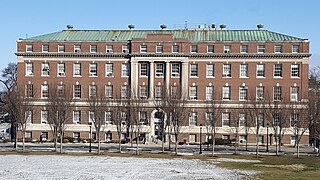
Ricketts Building is a building that is home to the Department of Chemical and Biological Engineering at the Rensselaer Polytechnic Institute in Troy, New York. It is named for Palmer C. Ricketts, the ninth president of Rensselaer Polytechnic Institute. The building opened in 1935. It is currently used for labs, lectures, and some clubs.
The Jonsson-Rowland Science Center , is home to the School of Science at Rensselaer Polytechnic Institute in Troy, New York. It is named for J. Erik Jonsson and Henry A. Rowland. The building was dedicated on 21 October 1961.
The Alumni Sports and Recreation Center is a building owned by Rensselaer Polytechnic Institute (RPI) in Troy, New York. It is host to sports facilities and to many clubs in the institute's community. It was purchased by the institute in 1971 from the State of New York, where it had previously served as the city armory for Troy.


